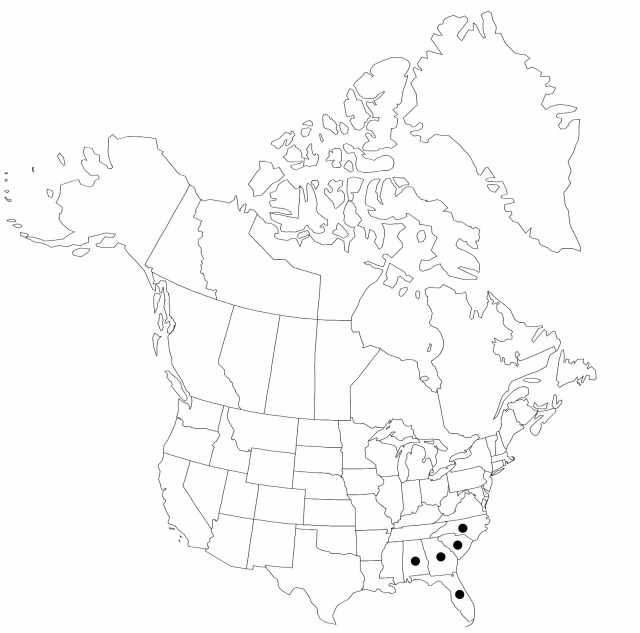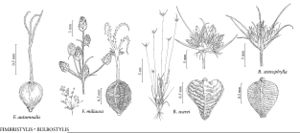Difference between revisions of "Bulbostylis warei"
Bull. Misc. Inform. Kew, addit. ser. 8: 26. 1908.
FNA>Volume Importer |
imported>Volume Importer |
||
| (5 intermediate revisions by 2 users not shown) | |||
| Line 7: | Line 7: | ||
|year=1908 | |year=1908 | ||
}} | }} | ||
| − | |basionyms={{Treatment/ID/ | + | |special_status={{Treatment/ID/Special_status |
| + | |code=F | ||
| + | |label=Illustrated | ||
| + | }}{{Treatment/ID/Special_status | ||
| + | |code=E | ||
| + | |label=Endemic | ||
| + | }} | ||
| + | |basionyms={{Treatment/ID/Basionym | ||
|name=Isolepis warei | |name=Isolepis warei | ||
|authority=Torrey | |authority=Torrey | ||
| + | |rank=species | ||
| + | |publication_title=Ann. Lyceum Nat. Hist. New York | ||
| + | |publication_place=3: 354. 1836 | ||
}} | }} | ||
|synonyms={{Treatment/ID/Synonym | |synonyms={{Treatment/ID/Synonym | ||
|name=Stenophyllus warei | |name=Stenophyllus warei | ||
|authority=(Torrey) Britton | |authority=(Torrey) Britton | ||
| + | |rank=species | ||
}} | }} | ||
|hierarchy=Cyperaceae;Bulbostylis;Bulbostylis warei | |hierarchy=Cyperaceae;Bulbostylis;Bulbostylis warei | ||
| Line 37: | Line 48: | ||
-->{{#Taxon: | -->{{#Taxon: | ||
name=Bulbostylis warei | name=Bulbostylis warei | ||
| − | |||
|authority=(Torrey) C. B. Clarke | |authority=(Torrey) C. B. Clarke | ||
|rank=species | |rank=species | ||
| Line 51: | Line 61: | ||
|publication title=Bull. Misc. Inform. Kew, addit. ser. | |publication title=Bull. Misc. Inform. Kew, addit. ser. | ||
|publication year=1908 | |publication year=1908 | ||
| − | |special status= | + | |special status=Illustrated;Endemic |
| − | |source xml=https:// | + | |source xml=https://bitbucket.org/aafc-mbb/fna-data-curation/src/2e0870ddd59836b60bcf96646a41e87ea5a5943a/coarse_grained_fna_xml/V23/V23_206.xml |
|genus=Bulbostylis | |genus=Bulbostylis | ||
|species=Bulbostylis warei | |species=Bulbostylis warei | ||
Latest revision as of 20:39, 5 November 2020
Herbs, perennial, densely cespitose, scapose. Culms (10–)15–40(–50) cm. Leaves 1/2 length of culms; sheaths brown to red-brown, glabrous, or scabrid along ribs; blades narrowly linear, 0.7–1 mm wide, flat or involute, glabrous or scabrid along ribs, margins distally scabrid. Inflorescences: scapes 5, erect to ascending, terete, many ribbed, 1–2 mm thick, stiff; spikelets in dense globose to hemispheric, involucrate heads, 1–2 cm wide; longer involucral bracts with setaceous blades usually exceeding inflorescence, basally dilating to broad pectinatefimbriate sheaths. Spikelets pale brown or redbrown, ovoid, somewhat flattened, 4–5 mm; fertile scales ovate, keeled, 4–5 mm, apex acute, puberulent, midrib included or excurrent as mucro. Flowers: stamens 3; anthers linear, 3 mm. Achenes white or yellowish, broadly trigonous-obovoid, 3-lobed, 1 mm, each lobe carinate, biconvex, apex retuse, surface coarsely, transversely rugose; tubercle a minute, dark button. 2n = 30.
Phenology: Fruiting summer–fall.
Habitat: White and yellow sandhills mostly in open evergreen oak pine, or deciduous scrub oak pine forest or sandy wasteland therein
Elevation: 0–200 m
Distribution

Ala., Fla., Ga., N.C., S.C.
Discussion
Selected References
None.
